|
Historic Sites of the U.S.-Mexican War
All the below listed sites are located in San Antonio, Texas.
Camp Crockett Site, San Antonio, Texas
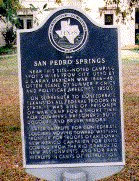
|
During August and September 1846, volunteer and regular troops under the command of General John E. Wool gathered at San Antonio de Bexar, Texas. Some of the regulars were camped near Mission Concepción while others were quartered in the city. Most of the volunteers set up their tents at a site located a few miles north of what is now downtown San Antonio. It was named "Camp Crockett" in honor of Alamo hero David Crockett. Its location is uncertain. A Texas State Historical Commission marker in San Pedro Park states that Camp Crockett was located there, near the springs which supply San Pedro Creek, but there is evidence that Camp Crockett was actually located in what is now Brackenridge Park - near the headwaters of the San Antonio River.
|
The historical marker shown here stands in front of the San Pedro Park branch library (Address: 1315 San Pedro). The large, tree-filled park is bounded by San Pedro Street on the east and N. Flores Street on the west. It is about four miles north of downtown San Antonio. Brackenridge Park, where the San Antonio Zoo is located, is accessible from Hildebrand Avenue, also north of downtown.
[Return to TOP]
Military Plaza, San Antonio, Texas
|
Spanish army barracks that stood in Military Plaza in San Antonio were probably used to house regular U.S. army troops under the command of General John E. Wool during the late summer of 1846. Wool himself may have had his headquarters here. The Old Spanish Governors' Palace, seen here, is the only building still standing in Military Plaza that existed at the time of the Mexican War.
|
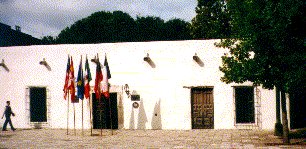
|
During the army's 1846 sojourn in San Antonio de Bexar, the well-known Madame Candalaria of Alamo fame is said to have run a fandago hall in this building. The fandango, a form of Mexican dance, was enjoyed by many U.S. soldiers while others were critical of what they viewed as a low form of entertainment. Today, the Spanish Governors' Palace (Address: 105 Plaza de Armas) is one of downtown San Antonio's primary historical attractions. It is located onthe west side of the plaza, on Military Plaza Street. There is a small admission fee. The plaza is bounded on the north by Commerce Street, on the east by Flores Street, and on the south by Dolorosa Street. The San Antonio City Hall, built in the 1890's, dominates the square.
[Return to TOP]
Main Plaza, San Antonio, Texas
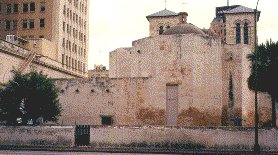
|
San Fernando Cathedral, an old Roman Catholic church, dominates Main Plaza, where U.S. soldiers entertained themselves in the plaza's saloons and fandango halls during the summer of 1846. One of the most infamous was the Bexar Exchange, the location of which is uncertain. It was immortalized by Sam Chamberlain in his postwar memoirs, "My Confession." Some soldiers also visited the cathedral, where they were captivated by the beauty of the Mexican señoritas praying there.
|
This view of San Fernando Cathedral actually shows the rear of the church, which faces Military Plaza. It is the only part of the building which looks the same as it did in 1846. The front of the structure, facing Main Plaza, was altered in 1868. San Fernando Cathedral is perhaps best known as the building from which Mexican General Antonio Lopez de Santa Anna flew the blood-red flag of "No Quarter" during the 1836 siege of the nearby Alamo. The church is open to the public except during weddings and other private ceremonies. None of the Mexican War-era saloons or fandango halls are still standing in Main Plaza.
Visit the San Fernando Cathedral web site.
[Return to TOP]
The Alamo, San Antonio, Texas
|
Although it is better known for the 1836 siege which resulted in the deaths of David Crockett, Jim Bowie, William Barret Travis and 184 other defenders, the Alamo also played a role in the U.S.-Mexican War. During the spring of 1847, soldiers attached to the U.S. Army Quartermaster Dept. moved into the old Spanish mission and began repairing the damage done to it eleven years earlier.
|

Photo courtesy Steven Butler.
Used with permission.
|
The construction of a roof atop the old church and the addition of the distinctive pediment for which the Alamo is known were among the repairs made before the end of the 1840's. During the Mexican War, and for many years afterward, the Alamo served as a supply depot. After Fort Sam Houston was established, the army moved out of the Alamo. Today, the old mission is owned by the State of Texas and is maintained as a "shrine" to Texas history by the Daughters of the Republic of Texas. Historical exhibits focus on the 1836 battle. Admission is free.
Visit the Alamo web site.
[Return to TOP]
Mission Concepcion Dragoon Campsite, San Antonio, Texas
|
The 2d Dragoons, commanded by the impetuous Col. William S. Harney, were camped near Mission Concepcion during 1845 and 1846, before marching south into Chihuahua with Wool's army. Among Harney's troops was a young Sam Chamberlain who recalled the day he and his fellow dragoons were detailed to remove bat guano from the old mission so it could be used to stable their horses. In the process, Chamberlain and his comrades disturbed the bats which filled the church.
|
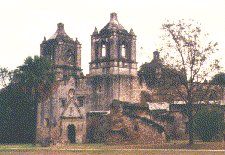
|
A water-color painting done by Chamberlain depicts a flood of bats pouring out the door and windows of the old Spanish mission.
Located about two miles south of downtown San Antonio, Mission Concepción is today administered by the U.S. National Park Service. The mission church still serves the community in which it stands, as an active Roman Catholic church. It is open, however, to the public (except during private ceremonies) and admission is free.
Visit the NPS Mission Concepción web site
[Return to TOP]
Mission San José, San Antonio, Texas
|
Mission San José, along with the Alamo and Mission Concepción, was sketched by Illinois volunteer Sgt. Edward Everett during the summer of 1846. Although no troops were stationed here, the mission was described by a number of individuals who passed by it on their way in and out of San Antonio during the Mexican War. Graffiti, carved into the soft stone of the church's entrance, bears silent witness to the visitors from this period and later. In his book, "My Confession," Sam Chamberlain recalled attending a fandango at one of the outbuildings at San José in 1846. There, he and his companions danced with a number of beautiful señoritas and had a little too much to drink.
The young dragoon reported that he and his friends were afterward confined to camp by Col. William S. Harney.
San José, known as the "Queen of the Missions," is today administered by the U.S. National Park Service. It is open to the public and admission is free. The mission lies about five miles south of downtown San Antonio, near the intersection of Roosevelt Road and S.W. Military Drive.
|
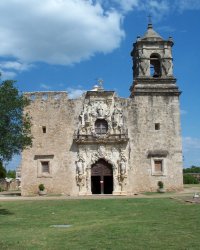
Photo courtesy Steven Butler.
Used with permission.
|
Visit the NPS Mission San José web site
[Return to TOP]
Captains Walker & Gillespie Gravesites, San Antonio, Texas

|
Captain Samuel Walker of the Texas Mounted Volunteers was one of the foremost American soldiers of the Mexican War. During the siege of Fort Texas in May 1846, it was Walker who rode through the Mexican lines to carry messages into and out of the fort. Later, Walker assisted gun manufacturer Samuel Colt in designing what became known as the Walker-Colt pistol, an early six-shooter much favored by the Texas Volunteers. In 1847, Walker was serving in Central Mexico when he was killed in a skirmish with Mexican guerillas at Huamantla. His body was returned to San Antonio, which he considered his home. His grave, shown here, is located in the Oddfellows Cemetery a few blocks east of downtown San Antonio. He lies beside Capt. William Gillespie, a Texan who was killed at the Battle of Monterey in September 1846.
|
The cemetery is located at the corner of Monumental & Paso Hondo Streets. Here's a map.
Here's a little more information about Captain Walker.
[Return to TOP]
Return to: [Historic Sites of the U.S.-Mexican War]
|